STS-3
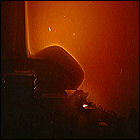 The testing phase of the shuttle program continues as Space Shuttle Columbia lifts off for her third flight into space. With Commander Jack Lousma and Pilot C. Gordon Fullerton aboard, Columbia stays in orbit for over a week, testing the orbiter’s endurance to heat at different angles to the sun, as well as testing the unmanned Spacelab experiment pallets in the cargo bay. This is the first shuttle flight to end on the contingency landing site at White Sands, New Mexico.
The testing phase of the shuttle program continues as Space Shuttle Columbia lifts off for her third flight into space. With Commander Jack Lousma and Pilot C. Gordon Fullerton aboard, Columbia stays in orbit for over a week, testing the orbiter’s endurance to heat at different angles to the sun, as well as testing the unmanned Spacelab experiment pallets in the cargo bay. This is the first shuttle flight to end on the contingency landing site at White Sands, New Mexico.
Endeavouring to keep spares on hand
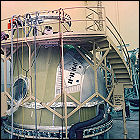 At Rockwell International, a spare Space Shuttle crew module is assembled alongside components intended for the orbiters Discovery and Atlantis, and though the spare isn’t intended for a specific shuttle yet to be built, it will find a purpose in the wake of the 1986 Challenger disaster: the spare crew module will become one of many completed shuttle spares that will eventually be assembled in the late 1980s as the Space Shuttle Endeavour, Challenger’s replacement and the last space shuttle constructed.
At Rockwell International, a spare Space Shuttle crew module is assembled alongside components intended for the orbiters Discovery and Atlantis, and though the spare isn’t intended for a specific shuttle yet to be built, it will find a purpose in the wake of the 1986 Challenger disaster: the spare crew module will become one of many completed shuttle spares that will eventually be assembled in the late 1980s as the Space Shuttle Endeavour, Challenger’s replacement and the last space shuttle constructed.
Columbia takes up arm
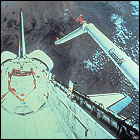 Key to NASA’s claim that the Space Shuttle will be able to deploy, retrieve and repair satellites is the Canadian-built remote manipulator arm system (or “Canadarm”), a project first contracted in 1975 and making its first appearance on Columbia‘s second flight. During tests, the arm performs exactly as expected, and proves to be absolutely vital to many future shuttle missions. The Canadian Space Agency and its subcontractors quickly receive further orders – a Canadarm for every shuttle in the fleet. Fuel cell problems shorten Columbia’s mission from five days to two days, but the crew still accomplishes most of the planned objectives and experiments.
Key to NASA’s claim that the Space Shuttle will be able to deploy, retrieve and repair satellites is the Canadian-built remote manipulator arm system (or “Canadarm”), a project first contracted in 1975 and making its first appearance on Columbia‘s second flight. During tests, the arm performs exactly as expected, and proves to be absolutely vital to many future shuttle missions. The Canadian Space Agency and its subcontractors quickly receive further orders – a Canadarm for every shuttle in the fleet. Fuel cell problems shorten Columbia’s mission from five days to two days, but the crew still accomplishes most of the planned objectives and experiments.
STS-2: Columbia rides again
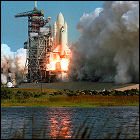 For the first time in history, a space vehicle returns to space for a second complete mission. Space Shuttle Columbia lifts off on its second test flight, with another two-man crew consisting of Joe Engle and Richard Truly, the first all-rookie American space crew since the last Skylab flight. Refinements to various systems are to be tested on this mission, as well as the first use of the remote manipulator arm, upon which nearly all claims of the shuttle’s ability to deploy, retrieve and repair satellites rest.
For the first time in history, a space vehicle returns to space for a second complete mission. Space Shuttle Columbia lifts off on its second test flight, with another two-man crew consisting of Joe Engle and Richard Truly, the first all-rookie American space crew since the last Skylab flight. Refinements to various systems are to be tested on this mission, as well as the first use of the remote manipulator arm, upon which nearly all claims of the shuttle’s ability to deploy, retrieve and repair satellites rest.
Fuel spill delays Columbia’s second launch
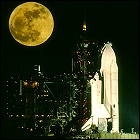 The second launch of Space Shuttle Columbia gets an unexpected one-month delay when a fuel leak forces NASA to remove, clean and re-attach 300 thermal tiles. The work can be done on-site, so Columbia simply stays on the pad. The second launch will be the last for the white external fuel tank, since NASA has determined that its brown insulating foam layer will cause no problems if left exposed; leaving off the coat of white paint saves several hundred pounds.
The second launch of Space Shuttle Columbia gets an unexpected one-month delay when a fuel leak forces NASA to remove, clean and re-attach 300 thermal tiles. The work can be done on-site, so Columbia simply stays on the pad. The second launch will be the last for the white external fuel tank, since NASA has determined that its brown insulating foam layer will cause no problems if left exposed; leaving off the coat of white paint saves several hundred pounds.
Salyut 6 expanded
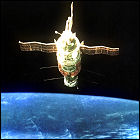 Launched unmanned in April, the Kosmos 1267 space station module docks automatically with the recently vacated Salyut 6 space station – the first-ever on-orbit expansion of a previously launched space structure. The module, a hardware holdover from the abandoned Almaz military space station program, provides engineers on the ground with information needed to safely add modules to the upcoming Salyut 7 space station to expand its habitable space. The experience gained will also be instrumental in the construction of the Mir station and the International Space Station. Kosmos 1267 remains docked to Salyut 6 until the combined structure tumbles out of orbit in 1982.
Launched unmanned in April, the Kosmos 1267 space station module docks automatically with the recently vacated Salyut 6 space station – the first-ever on-orbit expansion of a previously launched space structure. The module, a hardware holdover from the abandoned Almaz military space station program, provides engineers on the ground with information needed to safely add modules to the upcoming Salyut 7 space station to expand its habitable space. The experience gained will also be instrumental in the construction of the Mir station and the International Space Station. Kosmos 1267 remains docked to Salyut 6 until the combined structure tumbles out of orbit in 1982.
Soyuz 40
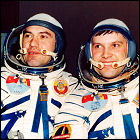 The final first-generation Soyuz spacecraft, Soyuz 40, is launched on a week-long spaceflight by the Soviet Union. With Leonid Popov and Romanian cosmonaut Dumitru Prunariu aboard, Soyuz 40 visits space station Salyut 6 for several days, and is the last spacecraft to dock at the five-year-old space station. The Soyuz 40 crew returns to Earth on May 22nd. Future Soyuz launches will use the upgraded Soyuz-T vehicles.
The final first-generation Soyuz spacecraft, Soyuz 40, is launched on a week-long spaceflight by the Soviet Union. With Leonid Popov and Romanian cosmonaut Dumitru Prunariu aboard, Soyuz 40 visits space station Salyut 6 for several days, and is the last spacecraft to dock at the five-year-old space station. The Soyuz 40 crew returns to Earth on May 22nd. Future Soyuz launches will use the upgraded Soyuz-T vehicles.
Columbia returns from orbit
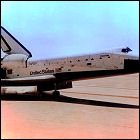 The first shuttle to return from space, Columbia touches down on the dry lake bed strip at Edwards Air Force Base in California, two days and six hours after liftoff (and after putting a cool million miles on the odometer). The aerodynamics involved in gliding after re-entry are found to be trickier than the previous test landings of the Enterprise. Inspection of the thermal tiles lining the shuttle’s belly reveals more damage than expected, and NASA begins working to refine the process of fitting the tiles to the shuttle.
The first shuttle to return from space, Columbia touches down on the dry lake bed strip at Edwards Air Force Base in California, two days and six hours after liftoff (and after putting a cool million miles on the odometer). The aerodynamics involved in gliding after re-entry are found to be trickier than the previous test landings of the Enterprise. Inspection of the thermal tiles lining the shuttle’s belly reveals more damage than expected, and NASA begins working to refine the process of fitting the tiles to the shuttle.
Columbia opens the doors
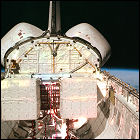 Safely in orbit, the cargo bay doors are opened for the first time on Space Shuttle Columbia, revealing that some of the shuttle’s protective thermal tiles are already missing. (A later post-landing inspection reveals that more than 100 tiles are damaged, and 16 tiles are completely lost, all probably due to unexpected vibration during launch.) NASA deems the damage non-critical and gives the go-ahead for a landing, even though it’s impossible to see what damage may have been done to the more critical tiles on the shuttle’s underbelly.
Safely in orbit, the cargo bay doors are opened for the first time on Space Shuttle Columbia, revealing that some of the shuttle’s protective thermal tiles are already missing. (A later post-landing inspection reveals that more than 100 tiles are damaged, and 16 tiles are completely lost, all probably due to unexpected vibration during launch.) NASA deems the damage non-critical and gives the go-ahead for a landing, even though it’s impossible to see what damage may have been done to the more critical tiles on the shuttle’s underbelly.
STS-1: Columbia’s first flight
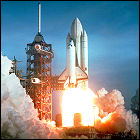 Space Shuttle Columbia lifts off on the shuttle system’s first flight into a space, with Commander John Young (a Gemini/Apollo veteran) and Robert Crippen aboard, the first two-man American crew since the Gemini program’s final flight in 1966. It’s a true test flight in every sense of the word – every previous American manned spacecraft had been flown unmanned first to verify safety and spaceworthiness, making the shuttle’s first flight a case where everything has to go perfectly the first time.
Space Shuttle Columbia lifts off on the shuttle system’s first flight into a space, with Commander John Young (a Gemini/Apollo veteran) and Robert Crippen aboard, the first two-man American crew since the Gemini program’s final flight in 1966. It’s a true test flight in every sense of the word – every previous American manned spacecraft had been flown unmanned first to verify safety and spaceworthiness, making the shuttle’s first flight a case where everything has to go perfectly the first time.
Columbia launch scrubbed
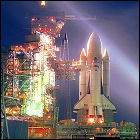 The first attempt to launch Space Shuttle Columbia on her maiden voyage is called off due to problems with the shuttle’s sophisticated system of redundant flight computers, some of which fail to synchronize with each other during the countdown. Over 24 hours are required to fix the bug, and the launch is delayed by two days.
The first attempt to launch Space Shuttle Columbia on her maiden voyage is called off due to problems with the shuttle’s sophisticated system of redundant flight computers, some of which fail to synchronize with each other during the countdown. Over 24 hours are required to fix the bug, and the launch is delayed by two days.
Soyuz 39
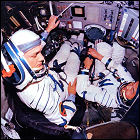 Soyuz 39 lifts off from the Soviet Union, carrying its two-man crew on a week-long spaceflight including a visit to space station Salyut 6. The crew consists of cosmonauts Vladimir Dzhanibekov and Jugderdemidiin Gurragchaa, the first Mongolian in space. In conjunction with the resident Salyut 6/Soyuz T-4 crew, they conduct scientific and engineering experiments, some of them studying the state of Salyut 6 after several years in orbit. The Soyuz 39 crew returns to Earth on March 30th.
Soyuz 39 lifts off from the Soviet Union, carrying its two-man crew on a week-long spaceflight including a visit to space station Salyut 6. The crew consists of cosmonauts Vladimir Dzhanibekov and Jugderdemidiin Gurragchaa, the first Mongolian in space. In conjunction with the resident Salyut 6/Soyuz T-4 crew, they conduct scientific and engineering experiments, some of them studying the state of Salyut 6 after several years in orbit. The Soyuz 39 crew returns to Earth on March 30th.
Soyuz T-4
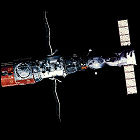 The Soyuz T-4 mission lifts off from the Soviet Union, carrying a two-man crew to space station Salyut 6. Cosmonauts Vladimir Kovalyonok and Viktor Savinykh remain about the station for 75 days, and are the last long-duration crew to occupy Salyut 6. Since they are still in orbit in April, they become the first Soviet crew to orbit the Earth at the same time as an American manned space vehicle since 1975, though the two never interact with each other at any point. The Soyuz T-4 capsule remains at the station as the escape vehicle until this crew departs in May.
The Soyuz T-4 mission lifts off from the Soviet Union, carrying a two-man crew to space station Salyut 6. Cosmonauts Vladimir Kovalyonok and Viktor Savinykh remain about the station for 75 days, and are the last long-duration crew to occupy Salyut 6. Since they are still in orbit in April, they become the first Soviet crew to orbit the Earth at the same time as an American manned space vehicle since 1975, though the two never interact with each other at any point. The Soyuz T-4 capsule remains at the station as the escape vehicle until this crew departs in May.
Columbia rolls out to the pad
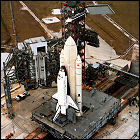 For the first time in the history of the delay-riddled Space Shuttle program, a complete, flight-ready vehicle is rolled out to the launch pad. Space Shuttle Columbia, atop the modified crawler vehicle which once carried Saturn V rockets to the pad, arrives at Cape Canaveral Launch Complex 39A, strapped to flight-qualified solid rocket boosters and a flight-ready external tank. (The shuttle Enterprise had been attached to empty boosters and tanks for fit checks as early as 1979.) Though preparation work continues to ready Columbia for flight, the shuttle is now in position for her first launch in 1981.
For the first time in the history of the delay-riddled Space Shuttle program, a complete, flight-ready vehicle is rolled out to the launch pad. Space Shuttle Columbia, atop the modified crawler vehicle which once carried Saturn V rockets to the pad, arrives at Cape Canaveral Launch Complex 39A, strapped to flight-qualified solid rocket boosters and a flight-ready external tank. (The shuttle Enterprise had been attached to empty boosters and tanks for fit checks as early as 1979.) Though preparation work continues to ready Columbia for flight, the shuttle is now in position for her first launch in 1981.
Soyuz T-3
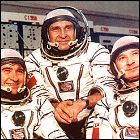 Soyuz T-3 lifts off from the Soviet Union’s Baikonur Cosmodrome launch complex, carrying the first three-man Soviet space crew since the early days of the Soyuz in 1971. Cosmonauts Leonid Kizim, Oleg Makarov and Gennady Strekalov also become the first three-man space station crew since the ill-fated crew of the first Salyut. Over a period of nearly two weeks, the crew conducts extensive repairs and upgrades to Salyut 6, readying the station for its next long-duration crew before departing on December 10th.
Soyuz T-3 lifts off from the Soviet Union’s Baikonur Cosmodrome launch complex, carrying the first three-man Soviet space crew since the early days of the Soyuz in 1971. Cosmonauts Leonid Kizim, Oleg Makarov and Gennady Strekalov also become the first three-man space station crew since the ill-fated crew of the first Salyut. Over a period of nearly two weeks, the crew conducts extensive repairs and upgrades to Salyut 6, readying the station for its next long-duration crew before departing on December 10th.
Soyuz 38
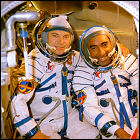 The Soviet Union launches Soyuz 38 on a mission to the Salyut 6 space station, carrying cosmonaut Yuri Romanenko and the first Cuban in space, Arnaldo Tamayo Mendez. The week-long flight includes docking maneuvers with Salyut 6 in pitch blackness, guided only by the lights on both the Soyuz vehicle and the station, and experiments aboard Salyut. Since the long-duration Salyut 6/Soyuz 35 crew is due to leave the station soon, the Soyuz 38 crew departs in the same vehicle in which it arrived.
The Soviet Union launches Soyuz 38 on a mission to the Salyut 6 space station, carrying cosmonaut Yuri Romanenko and the first Cuban in space, Arnaldo Tamayo Mendez. The week-long flight includes docking maneuvers with Salyut 6 in pitch blackness, guided only by the lights on both the Soyuz vehicle and the station, and experiments aboard Salyut. Since the long-duration Salyut 6/Soyuz 35 crew is due to leave the station soon, the Soyuz 38 crew departs in the same vehicle in which it arrived.
Soyuz 37
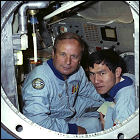 The Soviet Union launches Soyuz 37 on a week-long mission to visit space station Salyut 6. Part of the Interkosmos series, Soyuz 37 carries an international crew consisting of veteran cosmonaut Viktor Gorbatko and the first Vietnamese space traveler, Pham Tuan. Joint experiments are conducted with the long-duration crew of Salyut 6/Soyuz 35, and the Soyuz 37 crew departs in the Soyuz 36 capsule on July 31st, leaving the station crew with a fresh vehicle with which to make their own return home.
The Soviet Union launches Soyuz 37 on a week-long mission to visit space station Salyut 6. Part of the Interkosmos series, Soyuz 37 carries an international crew consisting of veteran cosmonaut Viktor Gorbatko and the first Vietnamese space traveler, Pham Tuan. Joint experiments are conducted with the long-duration crew of Salyut 6/Soyuz 35, and the Soyuz 37 crew departs in the Soyuz 36 capsule on July 31st, leaving the station crew with a fresh vehicle with which to make their own return home.
Soyuz T-2
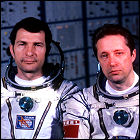 An advanced version of a new Soviet Soyuz spacecraft is launched with a crew for the first time. Soyuz T-2 is launched on a three-day mission to visit the Salyut 6 space station, with its primary goal to test a new automated approach and docking system for use with the Salyut space stations. After spending almost four days in orbit, cosmonauts Yuri Malyshev and Vladimir Aksyonov return to Earth; due to their vehicle’s flight test status, the T-2 crew does not swap spacecraft with the Salyut 6/Soyuz 35 crew.
An advanced version of a new Soviet Soyuz spacecraft is launched with a crew for the first time. Soyuz T-2 is launched on a three-day mission to visit the Salyut 6 space station, with its primary goal to test a new automated approach and docking system for use with the Salyut space stations. After spending almost four days in orbit, cosmonauts Yuri Malyshev and Vladimir Aksyonov return to Earth; due to their vehicle’s flight test status, the T-2 crew does not swap spacecraft with the Salyut 6/Soyuz 35 crew.
Soyuz 36
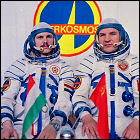 Soyuz 36 is launched by the Soviet Union on a one-week mission to space station Salyut 6. The crew consists of Apollo-Soyuz veteran Valery Kubasov and the first Hungarian in space, Bertalan Farkas. During the crew’s week-long visit to Salyut 6, they undertake an exhaustingly jam-packed series of experiments before swapping Soyuz vehicles with the long-duration station crew – technically, the Soyuz 36 crew returns in the Soyuz 35 vehicle on June 6th.
Soyuz 36 is launched by the Soviet Union on a one-week mission to space station Salyut 6. The crew consists of Apollo-Soyuz veteran Valery Kubasov and the first Hungarian in space, Bertalan Farkas. During the crew’s week-long visit to Salyut 6, they undertake an exhaustingly jam-packed series of experiments before swapping Soyuz vehicles with the long-duration station crew – technically, the Soyuz 36 crew returns in the Soyuz 35 vehicle on June 6th.
Soyuz 35
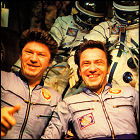 The Soviet Union launches Soyuz 35 en route to space station Salyut 6 for a long-duration stay. Cosmonauts Leonid Popov and Valery Ryumin set a new space endurance record with their 185-day stay, lasting until October 1980. Ryumin had been a member of the last Salyut 6 crew as well, having stayed on the station for six months in 1979, and was not originally scheduled for this mission, rotated into the prime crew due to the illness of the originally assigned crew member. Four other crews visit Salyut 6 during the Soyuz 35 crew’s stay. By the end of this mission, Ryumin holds a personal record for the most time accrued in space by a human being – 352 days, barely two weeks short of a full year of spaceflight experience.
The Soviet Union launches Soyuz 35 en route to space station Salyut 6 for a long-duration stay. Cosmonauts Leonid Popov and Valery Ryumin set a new space endurance record with their 185-day stay, lasting until October 1980. Ryumin had been a member of the last Salyut 6 crew as well, having stayed on the station for six months in 1979, and was not originally scheduled for this mission, rotated into the prime crew due to the illness of the originally assigned crew member. Four other crews visit Salyut 6 during the Soyuz 35 crew’s stay. By the end of this mission, Ryumin holds a personal record for the most time accrued in space by a human being – 352 days, barely two weeks short of a full year of spaceflight experience.
Atlantis under construction
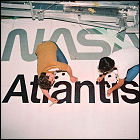 Construction begins on what is intended to be the fourth and final member of the current Space Shuttle fleet, Atlantis. With four orbiters in service, NASA will be one step closer to the routine, almost-weekly schedule of orbital flights envisioned in the Nixon-era mandate for the shuttle. Refinements and improvements in the process of constructing the shuttle fleet make Atlantis the lightest shuttle to date, over three tons lighter than Columbia.
Construction begins on what is intended to be the fourth and final member of the current Space Shuttle fleet, Atlantis. With four orbiters in service, NASA will be one step closer to the routine, almost-weekly schedule of orbital flights envisioned in the Nixon-era mandate for the shuttle. Refinements and improvements in the process of constructing the shuttle fleet make Atlantis the lightest shuttle to date, over three tons lighter than Columbia.
Discovery under construction
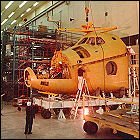 With NASA anticipating ramping up its launch schedule to more than one shuttle flight per month to meet demand for the vehicle’s unique satellite deployment and retrieval capabilities, construction begins on the third orbiter intended for spaceflight, Space Shuttle Discovery. Construction and checking of the third shuttle takes almost exactly four years, with Discovery’s first liftoff about a year later.
With NASA anticipating ramping up its launch schedule to more than one shuttle flight per month to meet demand for the vehicle’s unique satellite deployment and retrieval capabilities, construction begins on the third orbiter intended for spaceflight, Space Shuttle Discovery. Construction and checking of the third shuttle takes almost exactly four years, with Discovery’s first liftoff about a year later.
The Sky(lab) is falling
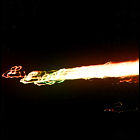 After intense solar activity results in a brief swelling of Earth’s atmosphere, Skylab‘s days are numbered: it has already been slowed enough by contact with the outermost layers of the atmosphere to come tumbling back to Earth. Unoccupied since 1974, the now-derelict space station is expected to disintegrate harmlessly over the Indian Ocean, but NASA is caught off-guard when unexpectedly large chunks of Skylab survive long enough to crash into the Australian outback. No one on the ground is hurt, and NASA is jokingly fined for littering.
After intense solar activity results in a brief swelling of Earth’s atmosphere, Skylab‘s days are numbered: it has already been slowed enough by contact with the outermost layers of the atmosphere to come tumbling back to Earth. Unoccupied since 1974, the now-derelict space station is expected to disintegrate harmlessly over the Indian Ocean, but NASA is caught off-guard when unexpectedly large chunks of Skylab survive long enough to crash into the Australian outback. No one on the ground is hurt, and NASA is jokingly fined for littering.
Soyuz 34: ghost rider in the sky
 The Soviet Union launches a redesigned vehicle, Soyuz 34, with no crew aboard. Under automated control, Soyuz 34 docks with space station Salyut 6, where it provides cosmonauts Vladimir Lyakhov and Valery Ryumin with a more reliable return capsule. Their original vehicle Soyuz 32 capsule is loaded with material to be returned to Earth, and it lands – unoccupied and without incident – on June 13th, and the station crew returns to Earth aboard Soyuz 34 in August.
The Soviet Union launches a redesigned vehicle, Soyuz 34, with no crew aboard. Under automated control, Soyuz 34 docks with space station Salyut 6, where it provides cosmonauts Vladimir Lyakhov and Valery Ryumin with a more reliable return capsule. Their original vehicle Soyuz 32 capsule is loaded with material to be returned to Earth, and it lands – unoccupied and without incident – on June 13th, and the station crew returns to Earth aboard Soyuz 34 in August.
Enterprise rolls out to the pad
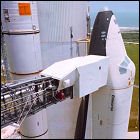 The Space Shuttle Enterprise, a full-sized, full-weight test article not intended for orbital flight, is mated to an external tank and a pair of solid rocket boosters and rolled out to Launch Complex 39A at Cape Canaveral for engineering fit-checks of the redesigned launch pad (a hand-me-down from the Apollo era, where the same pad had launched all but one of the Saturn V rockets). Enterprise remains on the pad for over a month, providing the first photo opportunity of the full-size shuttle launch stack in all of its glory.
The Space Shuttle Enterprise, a full-sized, full-weight test article not intended for orbital flight, is mated to an external tank and a pair of solid rocket boosters and rolled out to Launch Complex 39A at Cape Canaveral for engineering fit-checks of the redesigned launch pad (a hand-me-down from the Apollo era, where the same pad had launched all but one of the Saturn V rockets). Enterprise remains on the pad for over a month, providing the first photo opportunity of the full-size shuttle launch stack in all of its glory.
Soyuz 33: Soviet space snafu
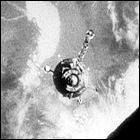 The Soviet Union launches Soyuz 33, intended to take cosmonauts Nikolai Rukavishnikov and Georgi Ivanov (the latter of whom is the first Bulgarian space traveler) to space station Salyut 6. But Soyuz 33 never reaches its destination. At a distance of 3,000 feet from Salyut, Soyuz 33’s main engine fails to fire – the first time such a failure has ever occurred in over a decade of Soyuz flights. Soyuz 33 is recalled to Earth at the earliest opportunity, leaving the station crew with no visits from any other human beings during their two-man, 175-day stay in orbit. It is later discovered that Soyuz 33’s engine could have exploded, causing critical damage to the entire vehicle – and ground controllers now focus their attention on Soyuz 32, docked at Salyut with an engine of identical design which could also fail.
The Soviet Union launches Soyuz 33, intended to take cosmonauts Nikolai Rukavishnikov and Georgi Ivanov (the latter of whom is the first Bulgarian space traveler) to space station Salyut 6. But Soyuz 33 never reaches its destination. At a distance of 3,000 feet from Salyut, Soyuz 33’s main engine fails to fire – the first time such a failure has ever occurred in over a decade of Soyuz flights. Soyuz 33 is recalled to Earth at the earliest opportunity, leaving the station crew with no visits from any other human beings during their two-man, 175-day stay in orbit. It is later discovered that Soyuz 33’s engine could have exploded, causing critical damage to the entire vehicle – and ground controllers now focus their attention on Soyuz 32, docked at Salyut with an engine of identical design which could also fail.
Columbia completed (almost)
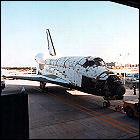 Space Shuttle Columbia is officially rolled out of the Rockwell International construction facility in Palmdale, California, even though her outer “skin” is still unfinished – NASA technicians continue working on perfecting the first spaceworthy shuttle’s thermal tiles for much of the next year, delaying the first launch until sometime in 1981 (just another in a series of delays for a vehicle that had been intended to fly as early as 1977).
Space Shuttle Columbia is officially rolled out of the Rockwell International construction facility in Palmdale, California, even though her outer “skin” is still unfinished – NASA technicians continue working on perfecting the first spaceworthy shuttle’s thermal tiles for much of the next year, delaying the first launch until sometime in 1981 (just another in a series of delays for a vehicle that had been intended to fly as early as 1977).
Soyuz 32
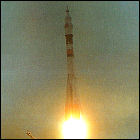 The Soviet Union launches Soyuz 32 on a long-duration mission to space station Salyut 6, with cosmonauts Vladimir Lyakhov and Valery Ryumin aboard. Over a record-setting 175 days, the new station crew conducts necessary repairs and upgrades to the station’s hardware, as well as conducting various experiments. With the arrival of equipment sent in the unmanned Progress 5 freighter in March, this is the first space crew to have a means to see ground controllers via a video link, rather than talking to them via radio; the cosmonauts also look forward to seeing family members during planned teleconferences. This is also the first crew to vacation in space, permitted a five-day break over May Day. Due to a major technical problem in the next manned Soyuz flight, the crew of Salyut 7 sets its duration record without a single visit from another cosmonaut.
The Soviet Union launches Soyuz 32 on a long-duration mission to space station Salyut 6, with cosmonauts Vladimir Lyakhov and Valery Ryumin aboard. Over a record-setting 175 days, the new station crew conducts necessary repairs and upgrades to the station’s hardware, as well as conducting various experiments. With the arrival of equipment sent in the unmanned Progress 5 freighter in March, this is the first space crew to have a means to see ground controllers via a video link, rather than talking to them via radio; the cosmonauts also look forward to seeing family members during planned teleconferences. This is also the first crew to vacation in space, permitted a five-day break over May Day. Due to a major technical problem in the next manned Soyuz flight, the crew of Salyut 7 sets its duration record without a single visit from another cosmonaut.
Christening the fleet
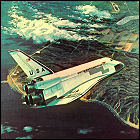 After several years of referring to the various Space Shuttle orbiters both under construction and in planning by numbers, NASA bestows names upon the anticipated fleet of four orbiters. OV-102, which is still expected to fly “late this year”, is named Columbia, while OV-099, undergoing conversion from a test article to flight-worthy vehicle, is named Challenger. Orbiters 103 and 104 will be named, respectively, Discovery and Atlantis; all four names are drawn from historical seafaring exploration vessels. (NASA has also used some of the names before: Columbia was the name of the moon-orbiting command module in the Apollo 11 mission, while Apollo 17’s lunar lander was named Challenger.)
After several years of referring to the various Space Shuttle orbiters both under construction and in planning by numbers, NASA bestows names upon the anticipated fleet of four orbiters. OV-102, which is still expected to fly “late this year”, is named Columbia, while OV-099, undergoing conversion from a test article to flight-worthy vehicle, is named Challenger. Orbiters 103 and 104 will be named, respectively, Discovery and Atlantis; all four names are drawn from historical seafaring exploration vessels. (NASA has also used some of the names before: Columbia was the name of the moon-orbiting command module in the Apollo 11 mission, while Apollo 17’s lunar lander was named Challenger.)
STA-099 to OV-099
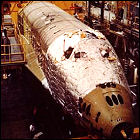 With a newly-awarded NASA contract in hand, Rockwell International begins the process of converting Space Shuttle Structural Test Article 099 into the Orbiter Vehicle 099, later to be christened Space Shuttle Challenger. A process originally envisioned for the test vehicle Enterprise, it is deemed more cost-effective and faster to upgrade STA-099 into OV-099. The first order of business is the construction of a new crew module, since the corresponding section of STA-099 was never actually intended to house human beings.
With a newly-awarded NASA contract in hand, Rockwell International begins the process of converting Space Shuttle Structural Test Article 099 into the Orbiter Vehicle 099, later to be christened Space Shuttle Challenger. A process originally envisioned for the test vehicle Enterprise, it is deemed more cost-effective and faster to upgrade STA-099 into OV-099. The first order of business is the construction of a new crew module, since the corresponding section of STA-099 was never actually intended to house human beings.